Atomic Structure Q16. The diagram below represents an ion propulsion unit used on a spacecraft launched in 1998.
Atoms of xenon-131 A negatively charged grid attracted the xenon ions, accelerating them out of the back of the ion propulsion unit and causing the spacecraft to be propelled forward.
(a) The mass of a Xe+ ion is 2.18 × 10–25 kg. Calculate the specific charge of a Xe+ ion. Give an appropriate unit for your answer. specific charge = charge/mass specific charge =1.60 x 10-19/2.18 × 10–25 specific charge = 7.34 x 105 [2 marks] (b) The storage tank contained 79 kg of xenon. When the ion propulsion unit was switched on it had an average power output of 2.1 kW. Each xenon ion gained 1300 eV of energy as it was accelerated and ejected out of the propulsion unit. Calculate the energy, in J, gained by each xenon ion. 1300 eV = 1300 x 1.6 x 10-19 J 1300 eV = 2.18 × 10–25 1300 eV = 2.1 x 10-16 J [1 mark] (c) Determine the length of time the ion propulsion unit operated before all of the 79 kg of xenon was used up. mass of xenon atom = 2.18 × 10–25 kg 79 kg xenon contains 79/(2.18 × 10–25) atoms each atom becoming an ion involves 2.08 x 10-16 J ∴ energy is 2.08 x 10-16 x 79/(2.18 × 10–25) energy = 7.54 x 1010 energy per second = 2100 J ∴ number of seconds = (7.54 x 1010)/2100 time = 3.59 x 107 s [3 marks] (d) Ion propulsion units could use helium ions instead of xenon ions. An ion of helium-4 Both ions would gain 1300 eV of kinetic energy in being accelerated and ejected from an ion propulsion unit. Suggest whether helium ions or xenon ions are better to use as a propellant in future space programmes. In your answer you should compare the relative speeds and momentum changes of the ions. The speed of the helium ions will be greater However momentum depends on mass and speed, and although helium has higher speed, it has considerably less mass and therefore less momentum would be gained by a helium ion during the acceleration compared to a xenon one. The helium ion would therefore exert less thrust on the spacecraft and therefore xenon is the better choice. [3 marks] (Total 9 marks) |
Follow me...
|






